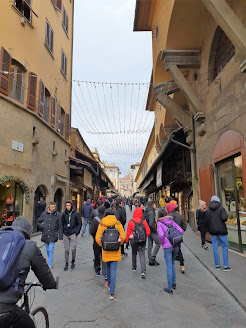Khokan, the AirBnb host allowed us for a late checkout around 1pm.
~~~
My first understanding of Florence is via their football club - Florentina, with David Ginola being their star player. Their distinct purple-white jersey was striking.
Florence is located almost in the middle of Italy, and is suitable as a mid-stop to Rome (in the south).
We took the 2.12pm Italo train from Venice Mestre station to Florence's Santa Maria Novella (SMN) station. The train ride took around 2 hours, with a top speed of 240km/hr. Our AirBnb was around 700m away from the train station, so it was convenient. The only challenge was that the room was on the 4th floor, via a narrow staircase. The facilities was good though, and we spent some time trying to work out the dishwasher. Giacomo was a friendly and helpful host.
La Bussulo walking tour guide - Nora (was knowledgeable) - Like most Medieval cities, a river strikes through
Florence, like Venice, was the center of Medieval Europe. The city was established by Julius Caeser in 59 BC. To read more, Wikipedia provides a comprehensive overview:
https://en.wikipedia.org/wiki/Florence
In 1300, Pope Boniface VIII said that Aristotle was wrong, the universe was made out of five elements, not four: Earth, Air, Fire, Water, and Florentines. (Ref: https://wikitravel.org/en/Florence)
This city is believed to have the highest concentration of art pieces.
Arno River - The 241km river is the most important in central Italy
There was a distinct social hierarchy in the past, and you could see that the worth of lives are different.
This is a church, and the noble people don't attend mass together with the commoners
Noble people have their own walkways (in air)
Sturdy buildings and brick houses rise above ground - Their foundation has to be solid
One of the main attraction of Florence is Michelangelo's David, standing at the entrance of Palazzo della Signoria (also known as Palazzo Vecchio). Commissioned in 1504, it was considered a masterpiece of the Renaissance. David's fiery eyes look towards Rome.
Today, this is a replica, while the original was shifted to the Academic Gallery in 1873
The Fontana del Porcelino - Like many tourist (traps) spots, placing a coin in the boar's mouth and see it drop thru the well gets good luck. If you touch the nose, you will come back to Florence
The unique white, red and green marbles are distinct. What a masterpiece!
There was actually a big problem during construction - No one knew how to build the dome - It was forgotten during the dark ages
The architect and engineer - Filippo Brunelleschi solved the challenge and build the dome, a world record then
Brunelleschi's dome - started by Vasari in 1568 and completed by Zuccari in 1579
Main altar
Front Facade
This was the time of the Renaissance. Medieval art was mostly religious, that is why, we only know the arts, but not the artist. Renaissance period was more open, and artist, architects, engineers flourished. Thus, people like Donatello, Michelangelo, da Vinci and co. are remembered forever. The financial support of tycoons and bankers like the Medici made the situation more desirable. This was a period when the double entry accounting system was introduced.
As compared to the Middle Ages, where most people were illiterate, and knowledge was controlled by the church, the Renaissance was a time to share knowledge, debate, and innovate. Modern printing was introduced in Mainz, Germany by Johannes Guttenberg, and people of the Renaissance read and wrote books, pamphlets, flysheets. It was like when social media was first introduced.
~~~
As the sun set around 3pm, the winter chill became apparent. It dipped till around 3 degrees Celsius. We found a stall selling mulled wine, and it was a timely boost.
There was a calmness in the air - This is one of the most important cities in Medieval Europe. It is so well-kept and preserved.
~~~
Up next, Rome - The Eternal City:

















No comments:
Post a Comment